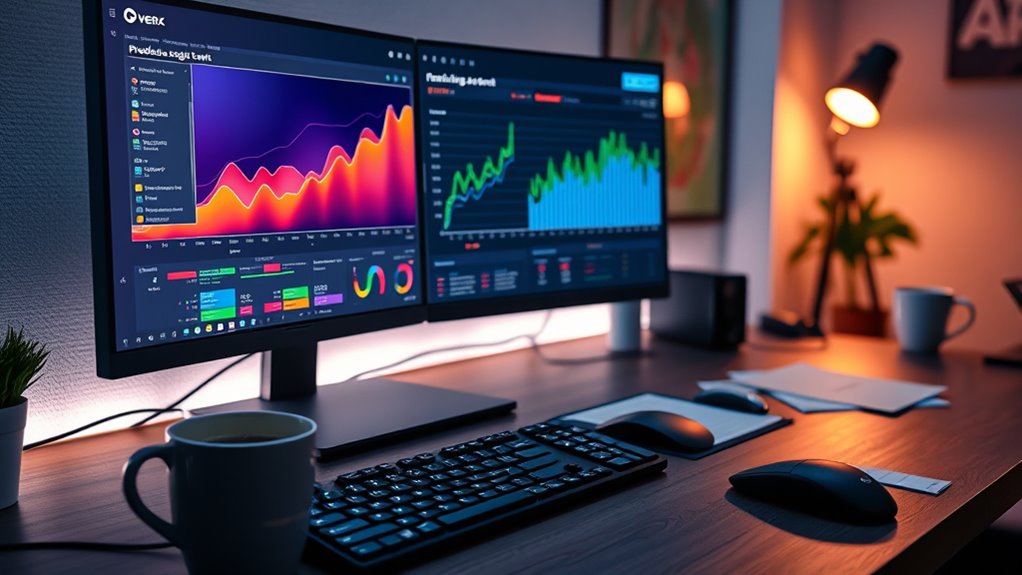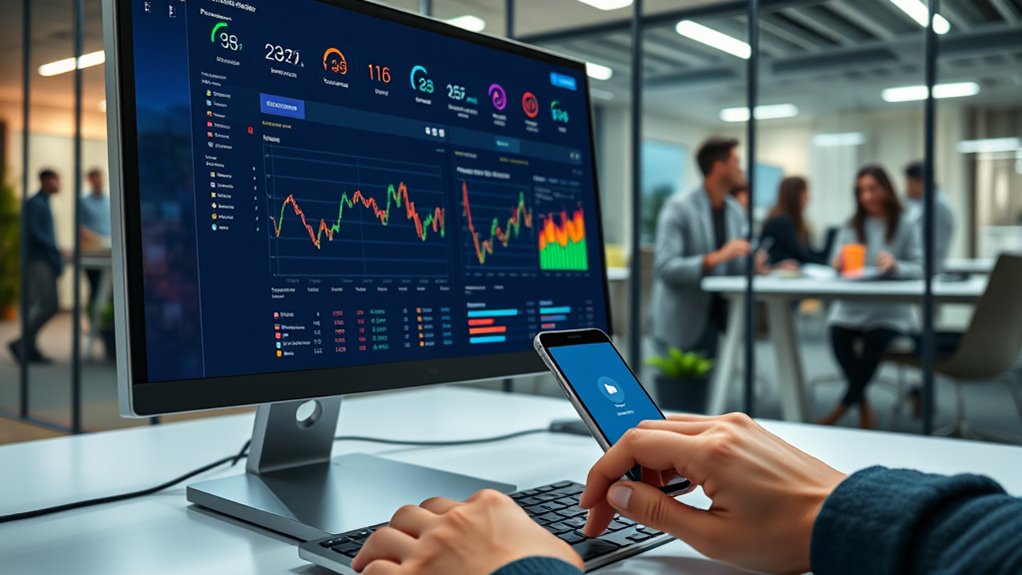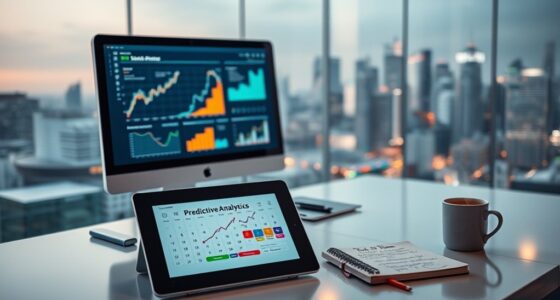To trigger emails from real-time product usage events, integrate your product with an event tracking system to log user actions instantly. Use segmentation strategies based on recent behaviors or lifecycle stages and set up automation tools to send personalized messages automatically. Focus on relevant content and well-timed delivery to boost engagement. By aligning your triggers closely with user actions, you’ll create more impactful campaigns—if you want to explore how to optimize this process, keep going.
Key Takeaways
- Integrate event tracking systems to log user actions instantly for trigger email activation.
- Develop segmentation rules based on real-time product usage data to target relevant audiences.
- Use automation tools to set up triggers that send personalized emails immediately after specific events.
- Ensure seamless data flow between event collection platforms and email automation systems for timely delivery.
- Continuously analyze engagement metrics to optimize trigger timing, content, and audience segmentation.
Understanding the Power of Real-Time Event Data

Real-time event data gives you immediate insights into how users interact with your product, enabling you to respond quickly and effectively. By leveraging event logging, you can track specific actions users take, such as clicks, page visits, or feature usage. This detailed data allows for behavioral segmentation, grouping users based on their real-time behaviors, preferences, and engagement levels. With this approach, you can identify patterns and tailor your trigger emails to match each user’s journey. Acting on this live data means you’re sending relevant messages at the right moments, increasing engagement and conversions. Understanding the power of real-time event data helps you create more personalized, timely, and impactful email campaigns that resonate with your audience. Incorporating content analysis can further refine your targeting strategies by revealing deeper insights into user interests and preferences.
Setting Up Your Trigger Email Infrastructure

To effectively send trigger emails based on user actions, you need to establish a solid infrastructure that captures and processes event data in real time. Start by integrating your product with an event tracking system that logs user behaviors instantly. This setup allows you to develop segmentation strategies, targeting users based on their recent actions or lifecycle stage. Use email automation tools to trigger personalized messages automatically when specific events occur, such as a cart abandonment or feature use. Guarantee your infrastructure supports seamless data flow between your event collection and email platform, enabling timely engagement. Additionally, ensuring your projectors have high contrast ratio capabilities can significantly improve how well your images are perceived, especially in darker viewing environments. By establishing this foundation, you’ll be able to deliver relevant, timely trigger emails that enhance user experience and drive conversions.
Designing Effective Trigger Email Campaigns

Creating effective trigger email campaigns requires careful planning to guarantee your messages resonate with users at the right moments. Focus on Segmentation Strategies to target users based on behavior, preferences, or lifecycle stage, ensuring relevance. Use Content Automation to deliver timely, personalized messages without manual effort. Consider these key points:
Effective trigger emails rely on strategic segmentation and automation for timely, personalized messaging.
- Segment audiences precisely for tailored messaging
- Automate content to respond instantly to user actions
- Craft clear, compelling calls to action for each trigger
- Test different segments and automation rules for optimization
- Incorporate Topical Authority by aligning your messaging with current trends and user interests to boost engagement and credibility
Best Practices for Personalization and Timing

Personalization and timing are crucial to the success of trigger emails because they directly influence user engagement and responsiveness. To achieve this, focus on customer segmentation, tailoring messages based on user behavior, preferences, and past interactions. Segmenting your audience allows you to send more relevant and personalized content, increasing the likelihood of action. Additionally, consider email frequency carefully; avoid overwhelming users with too many messages, which can lead to fatigue or unsubscribes. Instead, space out emails based on user activity and engagement levels. Personalization should extend beyond just using the recipient’s name—incorporate context, recent actions, and preferences. Proper timing ensures your emails arrive when users are most receptive, maximizing impact and fostering a positive experience. Understanding brand trustworthiness can also influence user receptivity to your messages, making your trigger emails even more effective.
Measuring Success and Optimizing Performance

Measuring success and optimizing performance are essential steps in refining your trigger email strategy. To do this effectively, focus on analyzing key metrics like open rates, click-through rates, and conversions. Use customer segmentation to identify which groups respond best to specific messages, tailoring your approach accordingly. A/B testing is crucial—test different subject lines, content, and timing to discover what resonates most. Regularly review your results and adjust your campaigns to improve engagement. Keep these principles in mind:
- Segment audiences for targeted messaging
- Experiment with A/B tests to optimize content
- Monitor performance metrics to identify trends
- Refine timing based on user behavior
- Incorporate performance metrics from heat pump systems to better understand energy consumption patterns and improve campaign targeting.
Frequently Asked Questions
How Do I Handle Data Privacy Concerns With Real-Time Event Tracking?
When handling data privacy concerns, you need to prioritize user consent and transparency. Always obtain explicit user consent before tracking real-time product events. Use data anonymization techniques to protect personal information and reduce privacy risks. Clearly communicate how data is collected, stored, and used, giving users control over their information. By implementing these practices, you guarantee compliance and build trust while effectively managing real-time event data.
What Are Common Challenges When Integrating Trigger Emails With Existing CRM Systems?
When integrating trigger emails with your CRM, you often face challenges like maintaining accurate customer segmentation and ensuring seamless user onboarding. You need to sync data efficiently, avoid duplicate records, and keep your messaging personalized. Sometimes, your existing CRM might not support real-time updates, causing delays. You must also manage data privacy and consent. Addressing these issues helps deliver timely, relevant trigger emails that improve user engagement and conversion.
How Can I Prevent Trigger Emails From Being Marked as Spam?
Imagine your trigger emails as welcome mats, inviting engagement, not spam. To prevent them from being marked as spam, focus on email personalization—tailoring content to your audience’s needs. Use clear, relevant subject lines and avoid spammy words. Maintain proper authentication, like SPF and DKIM, to pass spam filtering. Keep your list clean and encourage recipients to add you to their contacts, ensuring your emails land where they’re meant to.
What Tools or Platforms Best Support Real-Time Event-Based Email Triggers?
You should look for platforms that excel in real-time event-based email triggers, like Salesforce Marketing Cloud, HubSpot, or Braze. These tools support advanced personalization strategies and user segmentation, enabling you to send targeted emails based on user actions instantly. They help you craft timely, relevant messages that resonate with your audience, increasing engagement while reducing the chances of your emails being marked as spam.
How Do I Manage Trigger Emails for Users With Multiple Simultaneous Actions?
Managing trigger emails for users with multiple actions is like juggling flaming torches—you need control. Start by segmenting users based on behavior, so you send targeted messages. Use event prioritization to determine which actions are most important, avoiding email overload. Automate workflows to handle simultaneous actions smoothly, ensuring each user gets relevant, timely messages without chaos. This keeps your communication sharp and your users engaged.
Conclusion
By harnessing real-time product usage data, you become the navigator guiding your audience through a personalized journey, much like Orpheus with his lyre. When you set up effective trigger emails, craft compelling messages, and optimize performance, you transform fleeting moments into lasting connections. Remember, in this dance of data and engagement, your responsiveness is the key to turning prospects into loyal patrons—truly, a modern-day Midas touch in the domain of marketing.
Natali – Editor in Chief (Strategy and Mastery, AI Expert) Natali, our Editor in Chief, is the driving force behind our content’s strategic direction. With a keen eye for detail and a deep understanding of market trends, Natali ensures that our content is top-notch and strategically aligned with our client’s goals. Her expertise in AI helps to seamlessly integrate advanced technology into our marketing strategies, pushing the boundaries of conventional marketing.










